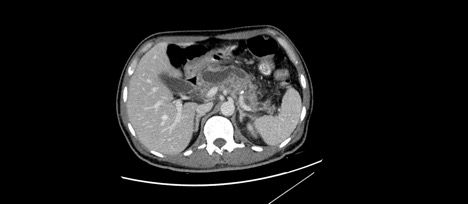Case Presentation: A 46-year-old male with a history of type II diabetes mellitus on metformin presented with five days of severe, post-prandial epigastric pain with inability to tolerate meals. Labs on admission were notable for mild hyperglycemia with finger stick blood glucose between 100 and 200 mmol/L with an anion gap of 21, pH 7.3, and serum bicarbonate 14mmol/L. Patient had an elevated serum beta-hydroxybutyrate to 3.3mmol/L with a negative lactate, negative osmolar gap, and no history of alcohol or salicylate use. Lipase was negative, liver function tests were within normal limits, and a right upper quadrant abdominal ultrasound was unremarkable. In the emergency room, he was presumed to have starvation ketosis from poor oral intake and admitted to medicine for further workup. CT angiogram of the abdomen was obtained given concern for mesenteric ischemia, and was notable for acute on chronic pancreatitis with marked pancreatic duct dilatation (See Figure 1). Patient was given intravenous fluids, intravenous opioids, and placed on an insulin sliding scale for diabetes management. Over the next 24 hours, the patient experienced increasing nausea with worsening anion gap acidosis. Finger stick blood glucose remained in the 100-200 mmol/L range. Patient was started on a continuous insulin drip for presumed euglycemic diabetic ketoacidosis (DKA), with significant improvement in his nausea and resolution of anion gap acidosis. Patient underwent endoscopic retrograde cholangiopancreatography (ERCP), and a gallstone was found in the pancreatic duct and treated with stenting and lithotripsy. The patient’s symptoms continued to improve following the procedure and he was discharged on an insulin regimen with endocrine, gastroenterology, and surgery follow-up.
Discussion: Euglycemic diabetic ketoacidosis (DKA) has been described particularly in type I diabetes patients with poor oral intake, treatment with insulin prior to arrival in the emergency department, or treatment with sodium-glucose co-transporter 2 (SGLT2) inhibitors.[1, 2] Euglycemic DKA can rarely be seen in the setting of acute pancreatitis, even without the presence of underlying diabetes.[3] We believe our patient presented with euglycemic DKA secondary to acute on chronic gallstone pancreatitis and in the setting of baseline insulin deficiency from chronic pancreatic disease. Starvation and alcoholic ketosis as well as salicylate toxicity were also on the differential for this patient. However, he denied any history of alcohol or salicylate use and bicarbonate levels generally stay above 18 mmol/L in starvation ketosis.[4] Our patient also had a negative lipase despite a history and imaging consistent with acute pancreatitis. Despite its high sensitivity and specificity, lipase negative pancreatitis has been reported especially in those patients with chronic pancreatitis secondary to destruction of acinar cells.[5]
Conclusions: We present a rare case of euglycemic DKA in the setting of acute on chronic gallstone pancreatitis with a negative lipase. This case highlights the importance of maintaining a high level of suspicion for euglycemic DKA in cases of marked anion gap acidosis with serum ketosis and understanding limitations of lipase testing in chronic pancreatitis patients.

